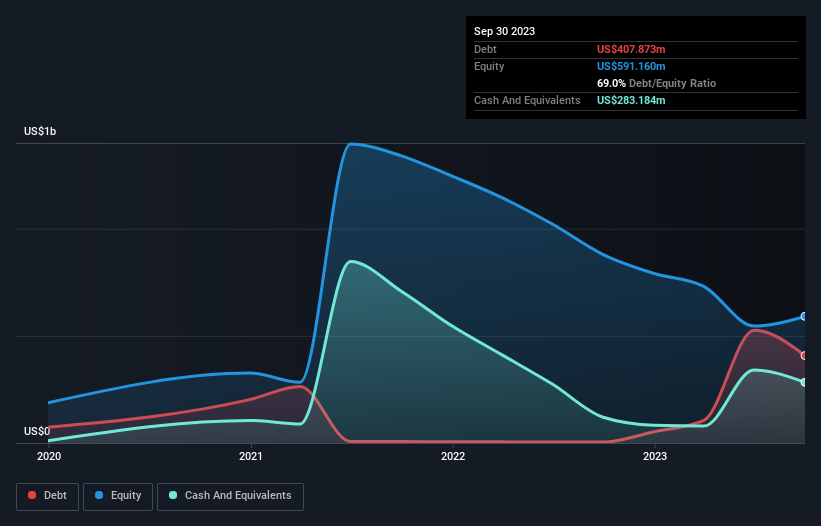Legendary fund manager Li Lu (who Charlie Munger backed) once said, 'The biggest investment risk is not the volatility of prices, but whether you will suffer a permanent loss of capital.' So it might be obvious that you need to consider debt, when you think about how risky any given stock is, because too much debt can sink a company. Importantly, Oatly Group AB (NASDAQ:OTLY) does carry debt. But the real question is whether this debt is making the company risky.
When Is Debt Dangerous?
Debt assists a business until the business has trouble paying it off, either with new capital or with free cash flow. Part and parcel of capitalism is the process of 'creative destruction' where failed businesses are mercilessly liquidated by their bankers. While that is not too common, we often do see indebted companies permanently diluting shareholders because lenders force them to raise capital at a distressed price. By replacing dilution, though, debt can be an extremely good tool for businesses that need capital to invest in growth at high rates of return. When we examine debt levels, we first consider both cash and debt levels, together.
Check out our latest analysis for Oatly Group
What Is Oatly Group's Debt?
As you can see below, at the end of September 2023, Oatly Group had US$407.9m of debt, up from US$4.42m a year ago. Click the image for more detail. However, it does have US$283.2m in cash offsetting this, leading to net debt of about US$124.7m.

How Healthy Is Oatly Group's Balance Sheet?
Zooming in on the latest balance sheet data, we can see that Oatly Group had liabilities of US$511.5m due within 12 months and liabilities of US$205.2m due beyond that. Offsetting these obligations, it had cash of US$283.2m as well as receivables valued at US$132.1m due within 12 months. So its liabilities total US$301.4m more than the combination of its cash and short-term receivables.
This deficit isn't so bad because Oatly Group is worth US$753.4m, and thus could probably raise enough capital to shore up its balance sheet, if the need arose. But it's clear that we should definitely closely examine whether it can manage its debt without dilution. The balance sheet is clearly the area to focus on when you are analysing debt. But it is future earnings, more than anything, that will determine Oatly Group's ability to maintain a healthy balance sheet going forward. So if you want to see what the professionals think, you might find this free report on analyst profit forecasts to be interesting.
Over 12 months, Oatly Group reported revenue of US$774m, which is a gain of 8.6%, although it did not report any earnings before interest and tax. We usually like to see faster growth from unprofitable companies, but each to their own.
Caveat Emptor
Importantly, Oatly Group had an earnings before interest and tax (EBIT) loss over the last year. Its EBIT loss was a whopping US$287m. When we look at that and recall the liabilities on its balance sheet, relative to cash, it seems unwise to us for the company to have any debt. Quite frankly we think the balance sheet is far from match-fit, although it could be improved with time. Another cause for caution is that is bled US$289m in negative free cash flow over the last twelve months. So in short it's a really risky stock. There's no doubt that we learn most about debt from the balance sheet. However, not all investment risk resides within the balance sheet - far from it. We've identified 3 warning signs with Oatly Group (at least 1 which is a bit concerning) , and understanding them should be part of your investment process.
At the end of the day, it's often better to focus on companies that are free from net debt. You can access our special list of such companies (all with a track record of profit growth). It's free.
New: AI Stock Screener & Alerts
Our new AI Stock Screener scans the market every day to uncover opportunities.
• Dividend Powerhouses (3%+ Yield)
• Undervalued Small Caps with Insider Buying
• High growth Tech and AI Companies
Or build your own from over 50 metrics.
Have feedback on this article? Concerned about the content? Get in touch with us directly. Alternatively, email editorial-team (at) simplywallst.com.
This article by Simply Wall St is general in nature. We provide commentary based on historical data and analyst forecasts only using an unbiased methodology and our articles are not intended to be financial advice. It does not constitute a recommendation to buy or sell any stock, and does not take account of your objectives, or your financial situation. We aim to bring you long-term focused analysis driven by fundamental data. Note that our analysis may not factor in the latest price-sensitive company announcements or qualitative material. Simply Wall St has no position in any stocks mentioned.
About NasdaqGS:OTLY
Oatly Group
An oatmilk company, provides a range of plant-based dairy products made from oats in Europe, the Middle East, Africa, the Asia Pacific, Latin America, the United States, Canada, Mainland China, Hong Kong, and Taiwan.
Fair value with imperfect balance sheet.
Similar Companies
Market Insights
Community Narratives




